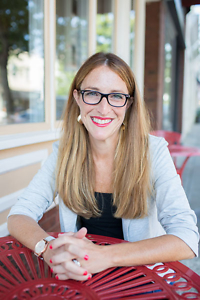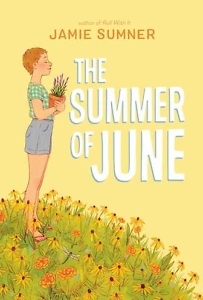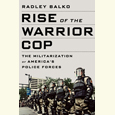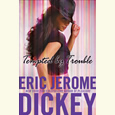Finding Her Place in the Sun
Jamie Sumner brings readers a 12-year-old girl who finds her courage
Twelve-year-old June Delancey has the best intentions for her summer break. She will finally do something about her anxious thoughts. It all starts with the clumps of hair on her bathroom floor — after all, if she shaves her head, she can’t pull out her own hair. “I am tired of being the nervous mouse girl who is scared all the time,” June tells herself at the launch of Jamie Sumner’s new middle-grade novel, The Summer of June. “This summer, I am going to be a lion.”

But June quickly learns that there’s much more to learning to manage her anxiety. With the help of her single mother, a librarian who shaves her own head in solidarity; her new friend Homer Juarez, a soccer star who loves poetry; a warm cast of secondary characters, all of whom have a fierce love for libraries; and her own newfound love of tending flowers, June is eventually able to put back the pieces of her summer after it rapidly falls apart.
This is the fourth children’s novel for Sumner, who makes her home in Nashville and has also written books for parents of children with special needs. Chapter 16 talked with her via email about telling June’s story.
Chapter 16: This isn’t the first time you’ve written a children’s novel set in Tennessee, but can you talk about your decision to set this in Columbia, a small town in Middle Tennessee? Do you have a connection to that town?
Jamie Sumner: The town where June lives is actually a bit of a mishmash of Columbia and my own town of Franklin, just south of Nashville. I based the library on my own lovely local branch. Another fun fact: Triple Crown Bakery is real and also in Franklin — and it is amazing. Go get a cinnamon roll! You won’t regret it.
Chapter 16: Librarians play a huge role in this book, and your own mother (as noted in the book’s acknowledgments) was your “first librarian.” How did libraries and books shape your life?
Sumner: One of my best memories as a kid was the book fair at school. I would run through those aisles like it was the candy store at the mall and grab whatever I could carry. When the pile grew so high that I could barely see to walk, I’d carefully (but not very skillfully) make my way to my mom’s library desk and set up my stack. Nothing was off limits. It was the best kind of freedom. Books opened my mind to the possibilities of other worlds, as well as the realities of my own. The library was the place that made all of that happen. Even now, whenever I walk into a library, I catch myself letting out a deep breath I didn’t know I was holding.
Chapter 16: Also at the back of the book is an author’s note, addressed directly at kids who worry. You write that you’re not ashamed of your own anxiety and that they shouldn’t be either. Did you build the character of June based in part on some of your own experiences or of those of loved ones in your life?
Sumner: June is both me and she’s not. Her worries and particular quirks are her own. However, she is comprised of traits in myself, as well as some of the students I worked with as a high school English teacher.
I was most definitely an anxious kid, and I am still an anxious adult (granted, with much better coping skills). For most of my life I thought something was wrong with me for needing routine or worrying about the future or taking things people said so much more deeply than others. On the flipside, my imagination was also more vivid, a kaleidoscope of other worlds. I didn’t fully understand that my genetic makeup created both those parts of me and that I needed to embrace the whole.
For better or worse, this is me and I’m proud of the mind and mentality I have been given. And I hope this book will help other anxious kids recognize the magic and deep value in themselves.
Chapter 16: At what point in the writing process did it occur to you that gardening would become a solace for June?
 Sumner: The garden came almost from the beginning. Barbara Cooney’s Miss Rumphius was one of my all-time favorite books as a child, and my mom did the very activity I mention in the book. She had each of us start our own seedlings to grow on the windowsills of the library. I have loved plants and being in the garden ever since.
Sumner: The garden came almost from the beginning. Barbara Cooney’s Miss Rumphius was one of my all-time favorite books as a child, and my mom did the very activity I mention in the book. She had each of us start our own seedlings to grow on the windowsills of the library. I have loved plants and being in the garden ever since.
There is something therapeutic and deeply soothing about working with your hands to settle your mind. For some, it’s knitting or painting or puzzles. For me it is the garden. Gardening is an act of trust: You hope upon hope this is a good batch of annuals and your perennials will return and the weather will cooperate and everything won’t wither when you go on vacation and then, ultimately, you have to let it all go and see what happens.
Chapter 16: After a character in the book rips up a black-eyed Susan that June had planted, she and her friend Homer try to salvage the flower, and you write: “We are trying to undo the trauma.” The world today can be scary for children (pandemic, climate crises, etc.). Do you think that books can help them face trauma and provide comfort?
Sumner: Absolutely, I do. Life is unpredictable. That’s scary for children and adults. Books create spaces to feel that unease within a safe framework. It’s not always a happy ending, but the story carries you through to a stopping place after which you can look up and process it. Books work double time as both windows to reality and also safety blankets for our psyches.
Chapter 16: Are you planning school visits so that you can tell students all about June, her wonderful “people,” and the value of focusing on the moment?
Sumner: Yes! After two very long years, I am finally getting out there again, and it feels wonderful! School visits give me that dose of student interaction and high energy that I miss from my teaching days. Also, nothing beats the blunt, random, no-punches-pulled questions from kids. They are honest and awesome, and I can’t wait to visit as many classrooms and libraries and conferences as I can.

Julie Danielson, co-author of Wild Things! Acts of Mischief in Children’s Literature, writes about picture books for Kirkus Reviews, BookPage, and The Horn Book. She lives in Murfreesboro and blogs at Seven Impossible Things Before Breakfast.





